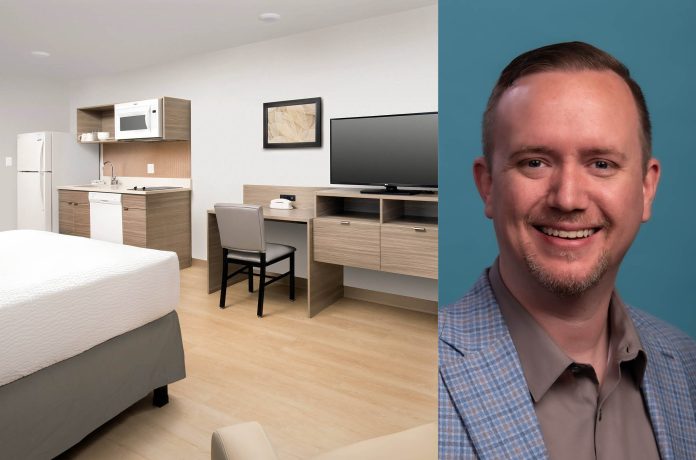
LODGING brings you the first installment of our three-part Ownership Series, providing owner perspectives on various hot topics and industry trends. We speak with J&P Asset Management about best practices and trends in the extended-stay segment. Look for the second article next month, offering advice on the conversion process. The third installment will focus on development and guest service trends in the leisure market.

J&P Asset Management manages 109 hotels, about 85 percent of which are economy and midscale extended-stay properties. While the company owns sliver portions across most of its portfolio, it focuses on providing a full suite of management services including revenue management, accounting, and property-level operations. Ryan Overman, J&P’s vice president performance improvement, recently spoke with LODGING on how owners can try to maximize profitability in the high-performing extended-stay space.
Lower Labor Costs
One of the basic best practices in extended stay is to maintain a pared-down onsite staff to keep labor costs down—typically about five to seven full-time associates per economy property, with variations based on the market. “When you only have three or four turns a day, your operating model is obviously very tight. So, we don’t run the front desk overnight on the economy properties, typically closing it around 10 p.m. and opening it around 9 a.m.,” Overman explained. “Depending on the model, you might have a night operator doing laundry or somebody that’s providing on-call services to accommodate any guest issues. But you typically aren’t staffing the desk overnight. Obviously, that’s going to significantly reduce your labor costs.”
Apart from these operating practices, the reduced need for labor is also based in the design of extended-stay properties. For example, Choice Hotels International’s WoodSpring Suites prototype includes features such as wall-hung furniture, wood-like vinyl floors in rooms and lobby areas, and adjacent washers and dryers in the back of the house—all of which save time for housekeeping staff. “Choice has taken a lot of time over the past five years to really understand the extended-stay model and what helps drive performance,” Overman remarked. “WoodSpring Suites became the blueprint for [the design approach to] Suburban Studios, Mainstay Suites, and Everhome Suites.”
Midscale extended stay tends to require a bit more staffing, since these properties cater to guests who might expect service well past 10 p.m., for example. Even so, the lean operating model is intended to set up an owner for a healthy profit margin throughout the year. “The beauty here is your labor costs in December and July are almost flat. So, there’s not even a big change in seasonality,” he noted. Moreover, the rising labor costs since COVID have not greatly impacted profitability in the sector. “Costs go up for everybody in hospitality, including us. But because our model is so slim, when our costs go up, they rise proportionally much, much smaller than they do for a traditional hotel,” he explained. “Where the traditional hotel might be carrying a burden of 400 hours a week, we carry a burden of 180 hours. And what’s nice about that is when everybody needs to raise ADR to accommodate the increased labor costs, we get a rise that follows that ADR rise across the market. But our operating expenses remain effectively stagnant. So, we see our margin increase.”
Staying Focused on the Target Customer
Extended-stay properties that are serving their intended clientele should have about three to four arrivals and three to four departures a day, Overman noted. “You’re also very limited as far as transient guests; we allocate up to 10 percent of our rooms to potential transient guests, which are people staying one to three nights.” Most guests should be staying 30 days or more. “If at any point, you have a lot of guests that are checking in for two weeks at a time, you have to ask yourself if you’re still targeting the right guest,” he said.
And while short-term guests are also important, property managers do well to prioritize the experience of their target customers, those staying 30 days or more. “When those guests come in, we want to make sure their rooms are extremely clean and that they receive great service. We typically escort them up to the room to make sure they’re comfortable with the space,” said Overman. “And we spend time getting to know extended-stay guests and making sure we’re meeting their needs, because that’s our real bread and butter. We want to make sure they’re happy and they’re renewing.”
When a major opportunity for transient business arises, extended-stary owners can be tempted to capitalize on it and temporarily disrupt their usual customer profile. But Overman maintained that’s not advisable, and forgoing those opportunities is “probably the hardest thing to wrap your head around if you’re coming from a non-extended stay operating model,” he said. “What makes you really strong as a traditional hotel is being very flexible to market changes. If you have an event in town for the weekend, you want to make sure your ADR is rising appropriately and that you’re capturing the demand before your competitors eat up that demand. So, for example, if a big-name artist is coming in for a concert, you want to make sure you’re selling out that property as fast as possible.” But in the extended-stay world, that approach is “the death knell,” he warned. “If you take the Taylor Swift business, you’re completely destroying your ability to operate effectively in that property, because you’ve now gone from three arrivals and three departures a day to 80 arrivals and 80 departures over that weekend, for example. And if I sell out my property eight months in advance to be ready for Taylor Swift, that’s eight months I cannot sell to extended-stay travelers. It takes a long time to acquire, accommodate, and hold on to those guests, so you want to make sure that the inventory is available.”
Patience in Pricing
Along with a stable focus on the extended-stay guest, owners and operators should aim to keep rates relatively stable. “In a traditional hotel, you want to be very fluid and flexible with pricing; you might be making rate changes multiple times a day, turning on demand generators. But in extended stay, you do not want to be shifting that price around frequently,” Overman said. Once a price is set, he advised keeping it in place for at least a week and sometimes a month to see if it’s capturing the market without seeing excessive demand (which indicates the price was set too low). “We are very slow and methodical with our price changes,” he said.
Revenue management based on data particular to the extended-stay space also helps owners draw as many of their target customers as possible. Accordingly, Overman recommends partnering with management companies versed in extended-stay revenue management, not just operations. J&P Asset Management, for example, makes decisions based on a custom-built data warehouse that consolidates information from various sources, including labor, accounting, and property management systems. “Revenue management is a key part of the operating model. Operations and revenue management must work hand in hand,” he asserted. “If your revenue strategy does not complement your operating model, you’re always going to be working against yourself.”











